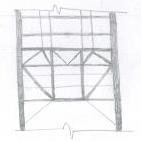Search the Community
Showing results for tags 'Diaphragm'.
-
As salamu alikum, What is the difference between of shell diaphragm & Joint diaphragm? Can anyone tell me the criteria for appropriate situation for different diaphragm application? Thanks in advance
-
In etabs, While assigning diaphragm to a story, we assign it to floor slab only of that story or even to beam in the story?
-
When a slab is designed in ETABS or SAP2000, usually the Membrane and diaphragm value is assigned to it. One of our structure designing professor assigned values of both membrane and diaphragm same and told us that, this will be always constant and same. I am a bit confused why so? What actually these parameters represents? I only knows the basic definition of Line element and surface element. When i opened the ABAQUS User manual it was clearly defined that, shell thin consider only in plane stresses while shell thick consider out of plan stress also which are i think shear deformations.
-
what is the purpose of assigning diaphragm b4 running analysis of concrete structure in ETABS and what type of diaphragm is required to be assigned to the structure as it shows us two types rigid and semi rigid. what role does these factors governs or play in the design of the structure?
-
Hi I want to know the use of diaphragms in etabs. i discus many people who are use etabs but i can't get justified answer about the application of etabs. I read the Technical reference of Etabs, where they write about Diaphragms. i get two type of diaphragms (plate or shell and joint or beam). My question. 1. When do i use Shell diaphragms (if floor present ) 2.When do i use joint diaphragms ( grade beam level where no slab are provide) NB: Diaphragms use to transfer the lateral load to the resisting element ( frame such as column. beam,shear wall)
-
What is difference between Rigid and Semi rigid diaphragm. I think if we assign semi rigid, We don't need to consider accidental torsion i.e 5% eccentricity. If we assign rigid, we must consider accidental torsion. And next question is difference between XCM and XCCM in case of rigid diaphragm. What is MassX and MassY. How to calculate XCCM and YCCM. And how they work.
-
aslamwalekum to all, when we need semi rigid diaphragm , i normaly take rigid diaphram for beam slab system , i got a vetting project (model made on ETABS 2016) , in which flat slab are used and semi rigid diaphram is assign , A/c to IBC 2006 , concrete slab with thickness more than 1.5 in , not consider as flexible diaphram , here is the code refrence. ''''''''''''''''''''''''''''''''''''''''''''''''''''''''''''''''''''''''''''''''''''''''''' 1613.6.1 Assumption of flexible diaphragm. Add the following text at the end of Section 12.3.1.1 of ASCE 7: Diaphragms constructed of wood structural panels or untopped steel decking shall also be permitted to be idealized as flexible, provided all of the following conditions are met: 1. Toppings of concrete or similar materials are not placed over wood structural panel diaphragms except for nonstructural toppings no greater than 11/2 inches (38 mm) thick. 2. Each line of vertical elements of the lateral- force-resisting system complies with the allowable story drift of Table 12.12-1. 3. Vertical elements of the lateral-force-resisting system are light-framed walls sheathed with wood structural panels rated for shear resistance or steel sheets. 4. Portions of wood structural panel diaphragms that cantilever beyond the vertical elements of the lateral- force-resisting system are designed in accordance with Section 2305.2.5 of the International Building Code ''''''''''''''''''''''''''''''''''''''''''''''''''''''''''''''''''''''''''''''''''''''''''' here in my case slab is 8 in thick , so can it be act as flexible diaphragm. i belive for metal decking , i can use semi rigid diaphram , but not for 8 in thick flat slab
-
Dear All, Could anyone suggest me assigning diaphragm like assigned in attached pic is correct for this building. If it is correct then how could we apply torsional irregularity in static load cases (earthquake case eccentricities override). I can calculate and apply it in simple building but in this building there would be two options of diaphragm( D1 & D2) in eccentricity override option in etabs ( If my assigned diaphragms are correct). which one i need to select.
-
While purpose of assigning diaphragm is to transfer inertial forces during earthquake to vertical members . There is general practice which I am following for quite a long time, that we most of the time don't consider inclined members like stair and ramp. i model them as horizontal slab. I have recently observed that there is a difference in the result while considering them as inclined members. My question is do we have to assign diaphragm to these inclined members (ramp or stair case)?
-
*SEFP Consistent Design* *Diaphragm Flexibility* *Doc No: 10-00-CD-0004* *Date: August 07, 2014* I am writing this article about a very important, but mostly neglected topic of flexibility of diaphragm. I used to assume that all reinforced concrete slabs can be treated as rigid diaphragms. But as it turns out, only the slab with span-to-depth (depth is length of slab in direction of lateral loads) ratio of less than 3 and without horizontal irregularity can be treated as rigid diaphragm. The more important thing is that the span-to-depth ratio and horizontal irregularity is not the only criteria and one other factor also needs to be kept in mind before assigning rigid diaphragm to concrete slabs in numerical model of building. Another important concept that I learned, and it was a moment of epiphany for me, is about TRANSFER diaphragms. I had posted a topic “Amplification Of Forces In Etabs” earlier in this forum but we were not able to reach at a satisfactory conclusion. Now, I have the answer to that query: Back Stay effect. Another article is required to explain it , and this concept is not discussed in this article. This article is about flexibility of diaphragm. Diaphragms are horizontal members of the lateral-force resisting system of building structures. Their function is to distribute inertial forces, generated at its own level, as well as other levels, to vertical members of lateral-force resisting system. One kind of diaphragm only distributes inertial forces generated at its own level. This kind of behaviour is observed in buildings where there is a continuity of vertical members of lateral-force resisting system: building should not have a setback or podium at lower levels, or below grade levels. The other kind of diaphragm, known as “Transfer diaphragm”, not only distributes inertial forces generated at its own level, but also re-distributes forces coming from upper levels. This type of behaviour is typical of a building having setback or podium at lower levels, or below grade levels. Transfer slabs can attract huge forces due to a behaviour dubbed as BACKSTAY EFFECT. Now, coming to the issue of flexibility of diaphragm. According to ASCE 7-10, In addition to considering aspect ratio and horizontal irregularity as a basis for assuming concrete slab as a rigid diaphragm, the relative stiffness of adjoining vertical lateral load resisting system. Buildings with shear walls at ends and flexible frames in between are the ones where the assumption of rigid diaphragm leads to underestimation of drifts and erroneous distribution of base shear in vertical as well as horizontal direction (1)(2)(3); shear forces in middle frames can be reduced to 23% if rigid diaphragm is assigned in the model (1) for buildings with this type of structural configuration. M. Moeini et al. (2008) (3) conducted a parametric study using numerical analysis and proposed formulae that predicts the error associated with assuming concrete slab as rigid diaphragm. They also concluded that for buildings, without shear walls, rigid diaphragm assumption is suitable for irregular buildings as well. But, for long and narrow buildings with shear walls at ends, the assumption of rigid diaphragm is not suitable. The objective of writing this article was to warn engineers about the tendency of blindly assigning rigid diaphragm to concrete slab in any type of building configuration. The result could be underestimation of forces as well as drifts. Nakashima, M., Huang, T., Lu, L-W. “ Effect of Diaphragm Flexibility on Seismic Response of Building Structures”, In proceedings of 8th world conference on earthquake engineering. San Luis Obispo, MSc Thesis , “ An Investigation of influence of diaphragm flexibility on building design through comparison of forced vibration testing and computational analysis”, 2010. M. Moeini, B. Rafzey, W.P. Howsen, “Investigation into the floor diaphragm flexibility in rectangular reinforced concrete buildings and error formulae”, In proceedings of 14th world conference on earthquake engineering. The article is not finalized and would be completed in coming weeks.
- 4 replies
-
- diaphragm
- diaphragm flexibility
- (and 2 more)
-
Assalam o alaikum, ACI 21.11.1 tells about diaphragms in seismic zones. My building is in zone 4 and it is frame structure. i have provided SMRF. Is my slab going to act as Diaphragm? Since diaphragm means elements that transfer horizontal forces to vertical elements. and slab becomes cause of major horizontal inertial force and it transfer lateral forces to beams which transfer to columns. Is my slab diaphragm??
-
Can anyone tell me while assigning the diaphragm when we have to choose the semi rigid or rigid. What exactly it does with the structure in ETABS? As far my understanding I am applying rigid diaphragm for concrete structure and semi-rigid for steel structures / car park structures. Regards










.thumb.jpg.700916fbc7ead330085e15745d0270bd.jpg)